Notes from MASS Zoom meeting on March 26, 2021
We had a good turnout for our 73rd meeting. Dean, Keith, Phil, Hank, Harry and I were there for our 9th get-together on Zoom. We were now comfortable enough with Zoom to have Keith record the meeting. We’ll see how well our meeting translates into video format after Keith gives it a once over.
To lead things off, I told the group that it has been a rough week for me. I haven’t been able to get more than 2 hours of sleep at a time due to some back and neck muscle problems. It’s hard to tell what is the cause, but I started some basement free weights exercise a couple of weeks ago and I also began working on a 1000 piece circular moon puzzle about 10 days ago. I think my troubles are from trying to find the pieces of that puzzles that are every shade of gray in the universe. Here it is about 2/3’s complete. It is a surprisingly addictive but a painful experience.
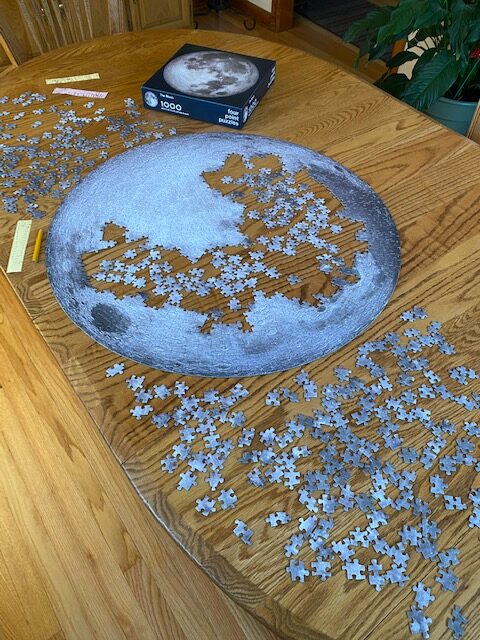
We then pressed on to our main topic of the Perseverance (Percy) rover on Mars. I started with showing the 3 rover sizes that the US has landed on Mars. It is amazing how far we’ve come from the original remote control car sized Sojourner rover in 1997, to the over 1 metric ton nuclear powered Percy and Curiosity rovers which are the size of of a compact car. I then shared a few zoom-in shots from the Percy’s first panoramic picture from Mars. Many of the features are from wind eroded rocks. The dust on Mars is the consistency of talcum powder. You wouldn’t think it could sculpt rocks but give it 3 billion years and it can make some interesting shapes. The first picture is called the “Harbor Seal” rock (see below). The people at JPL can come up with some innovative names. The plan is to name things around the Percy landing site with words from the Navajo language. The next picture is a mesa-like feature in the distance (also see below). It is a remnant of the river delta deposits where the surrounding softer rock has be eroded away. The last picture is the tire tread tracks from the rover’s first drive. Percy has a new wheel design that hopefully will stand up to the sharp Martian rocks better than the ones on the Curiosity rover. The first drive was simple. It consisted of 4 meters forward, turn 270 degrees and then back up a few meters. It took 33 minutes for the rover to move the 6.5 meter total distance which works out to .01 mph. Percy will be able to make much more distance when the drivers are more comfortable with its performance. With Percy’s enhanced navigation capabilities, it should be able travel 200 meters in a Martian day (a sol). That distance is 5 times farther than Curiosity could travel in a sol.

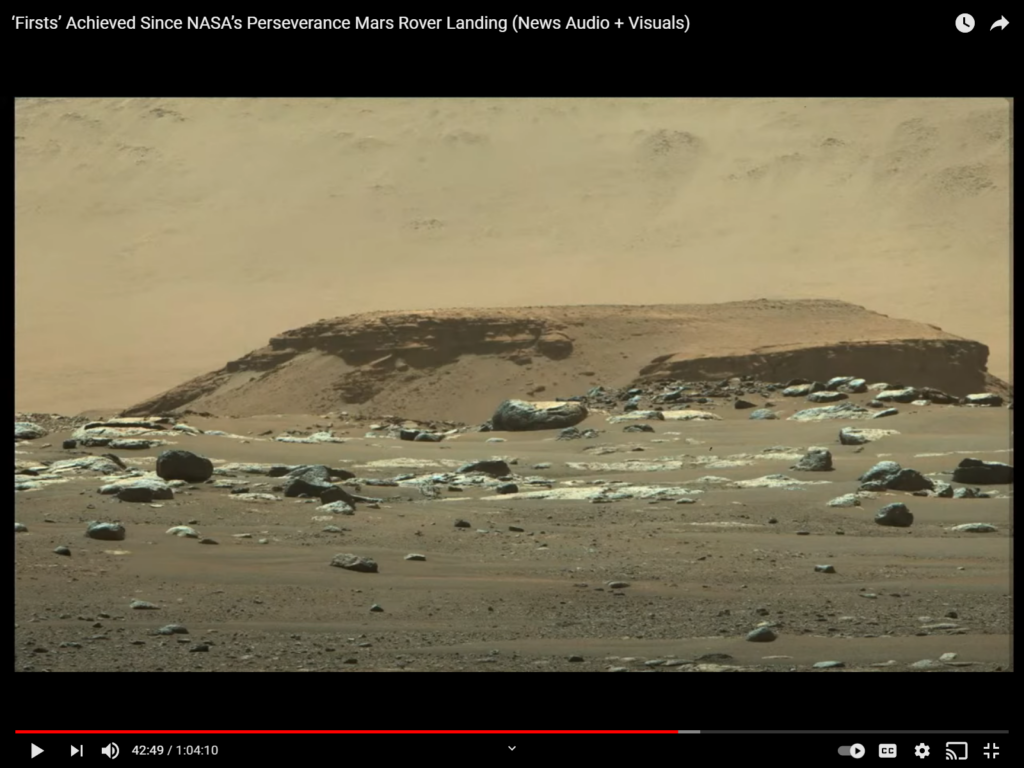
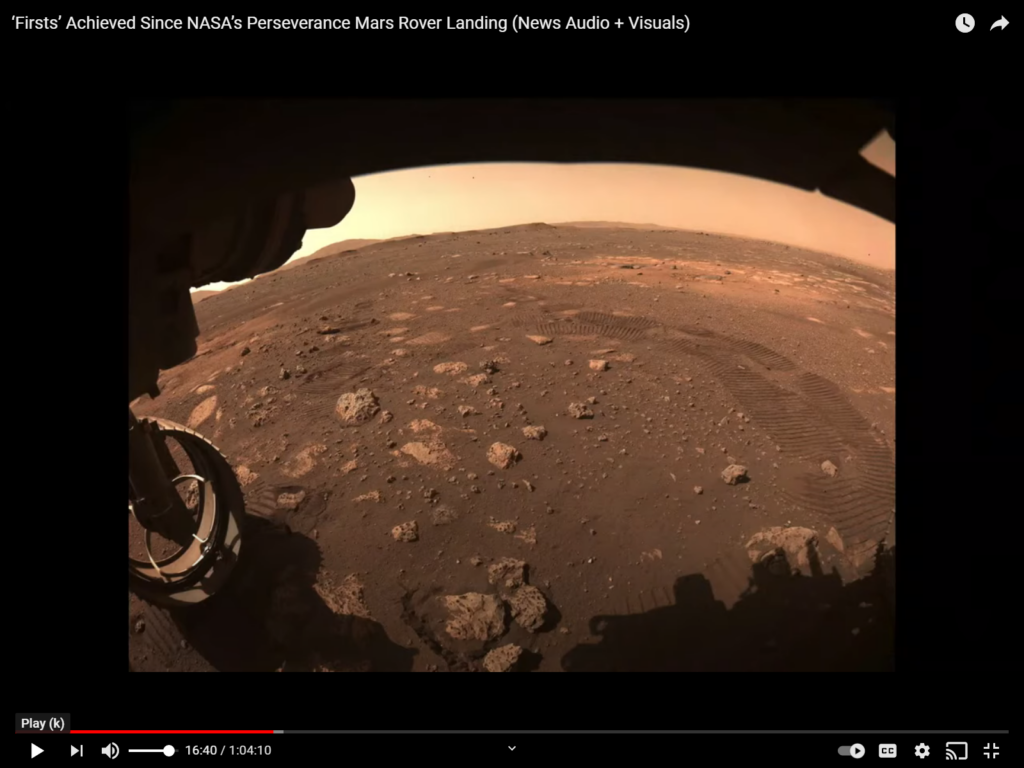
All the included pictures are screen shots from an hour long JPL news conference.
Instructions for the rover are transmitted each sol. Because the communication time delay between Earth and Mars varies from 3 to 22 minutes, the rover is expected to do its instructions on its own. At this point in time the delay is about 11 minutes. Scientists also don’t want the rover to move during the cold Martian night (temperatures can drop to minus 140 F), because joints could be too stiff and brittle. Organizing movement during daylight on Mars means the rover support team has to work on Martian day time which is 24 hours and 40 minutes long. With the extra 40 minutes each sol, the team goes thru a 40 earth day cycle which can be quite grueling. If you want to see what sol Percy is on or look at the latest pictures go to this site.
The next exciting thing for Percy will be deployment of the Ingenuity helicopter. Ingenuity is a high risk technology demonstration component of the rover. With its up-close aerial perspective, engineers hope it will provide the information needed to decide which of the 2 rover paths to take.
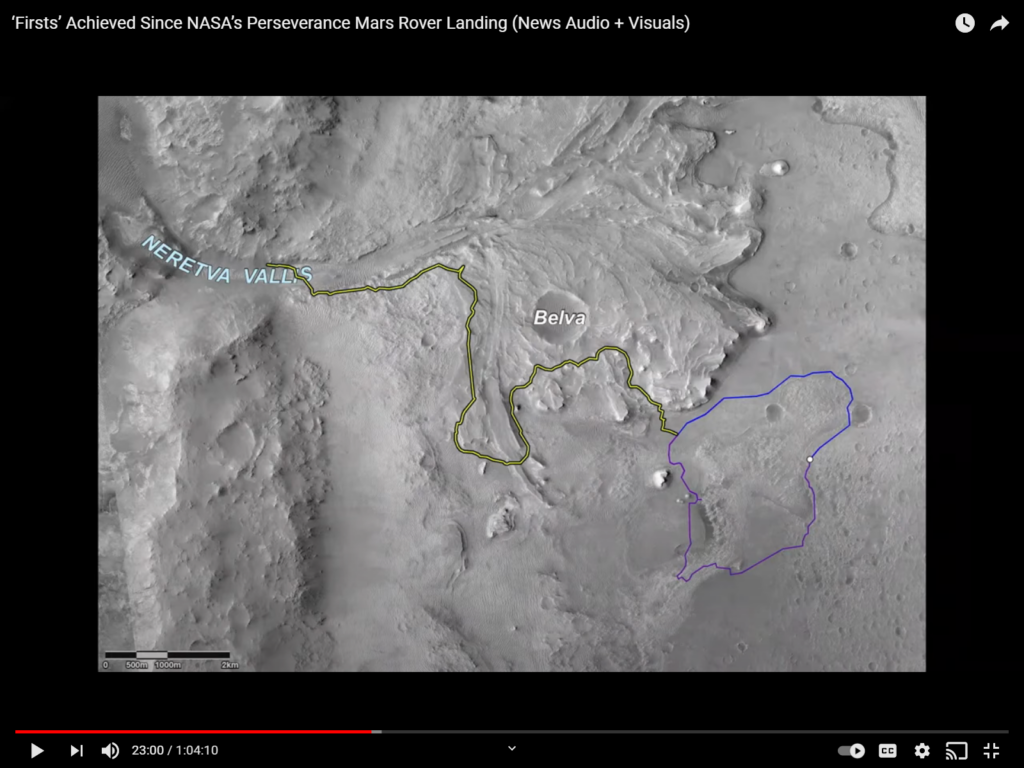
Ingenuity was rapidly and inexpensively developed. Its cost was only $80 million and it uses many off-the-shelf components. Its computer is so recent that it is 150 times faster than the 10 year ago selected computer on the rover. Because the parts haven’t been radiation hardened or protected so much from the cold, the helicopter is only expected to last 40 days on Mars. Therefore, April will be the month for Ingenuity. First flight is scheduled for about April 8th. Percy must first drop Ingenuity to the ground and drive away within 25 hours to get Ingenuity in the sunlight so it can charge up its batteries. Charged batteries are needed to keep it warm during the Martian night. The first flight will be simple, rise 3 meters (11 feet), hover for 30 seconds and then land. During the flight, Ingenuity will be making a movie of what it sees and Percy will be taking a video of it flying. It should be great to watch when it gets downloaded to Earth. Scientists have found a suitable flat area, now called the “airfield” to drop the copter. Percy will drive outside the “flight zone” about 60 meters from Ingenuity. This helps insure that Ingenuity doesn’t crash into the $2.9 billion rover. The safe observing spot has been named the Jacob Van Zyl overlook. Van Zyl was a JPL project director who helped develop the copter who died suddenly last year. This site shows the protective cover dropped from the belly of Percy, a short 1-minute video of Ingenuity’s first flight and a picture of the airfield. Ingenuity hopes to fly up to 5 times getting a little more complicated with each flight. It doesn’t plan to ever get higher than 5 meters (16 feet) because that is the limit of its laser altimeter to sense how high it is. To commemorate the significance of this first powered flight on another celestial body, NASA placed a postage stamp sized piece of fabric from the wing of the Wright brothers plane under the solar panel. Ingenuity could be the pathfinder to another planned helicopter NASA wants to fly to Titan, the largest moon of Saturn. Dragonfly is the mission name and it is intended to launch in 2026 and touch down on Titan in 2034. This site has a short video of the mission that shows how a parachute can be used because Titan has a atmosphere even more dense than Earth’s. Dragonfly will be nuclear powered because getting solar energy at the distance of Saturn and with the permanent clouds of Titan is very difficult.
As a final topic about Percy, I was stunned by the ethnic diversity of the JPL support team. The director Van Zyl of Ingenuity was from Namibia, the Ingenuity pilot has the name Håvard Fjær Grip and is Norwegian, others are Indian or Black. Sometimes the best and brightest seek out our country for opportunity to pursue their passion.
Remember, one of the primary objectives for Percy is to cache tubes of drilled rock segments for possible return to Earth for analysis. Northrop Grumman recently received a contract to develop the solid-fuel rocket to take those samples off Mars so they can dock with an orbiting probe that will send them back to Earth. The cost-plus, fixed fee contract is worth up to $84.5 million. The rocket would land on Mars with a fetch rover that would pick up the samples and deliver them to the rocket payload section. It is a very complicated and expensive mission, but getting the samples back to Earth where they could be analyzed by instruments that never could be miniaturized and sent to Mars will be invaluable in determining whether any rock samples contain the remains of ancient life.
The last topic on Mars was a quick discussion of the other 2 probes sent in 2020. The UAE orbiter named HOPE has entered its science orbit and will be an invaluable asset to study Martian weather and how the atmosphere interacts with space. The Chinese probe is still in orbit with its lander and rover. Information is hard to find on when it will attempt to land.
For our next set of topics, we moved to issues with NASA. First up was the positive result from the second “Green Run” test firing of the Artemis 1 core stage. This time the 4 RS-25 engines, all of them taken off various Space Shuttles, burned thru 700,000 gallons of liquid hydrogen and oxygen during a full 500 second firing down at Stennis Space Center in Mississippi. This simulated a full firing that the core stage would go thru as it ascends into space. There was a small fire visible at the base of one of the engines but NASA said that was due to some special thermal shielding made out of cork. This shielding would not be on the rocket when it is fired for launch. With a successful “Green Run” the core can now be prepped and sent to Florida for assembly into the Artemis 1 SLS rocket. It is scheduled to arrive at KSC by the end of April. All other components of Artemis 1 rocket, like the Orion capsule, solid rocket boosters and second stage are all ready and waiting for assembly. NASA still has a November 2021 date for launch of Artemis 1. This will be a 26-42 day mission that will send an unmanned Orion capsule around the moon and then splash down in the ocean. If that is successful, Artemis 2 will have a crew and do a similar loop around the moon and Artemis 3 would attempt to land a crew at the the south pole of the moon.
The next topic was the naming of ex-Senator Bill Nelson as Biden’s NASA Administrator. He is the former Democratic Senator from Florida. He famously criticized Jim Bridenstine for being a politician when Jim was being confirmed as the NASA head. Most people think that Bridenstine did a pretty good job of sheparding NASA’s budget thru Congress. The linked article states that if you consider Bridenstine a Jedi Master of politics, Nelson more resembles a Sith lord. I’m not that up on Star Wars references but that doesn’t seem very flattering. When he was a member of the House, he used his position to obtain a slot on a space shuttle flight. He had no qualifications other than he controlled a lot of NASA funding. Astronauts resented his presence so much they gave him the nickname, “ballast”, (see him in his blue flight suit in the linked site). He’s also a parent of the SLS. Ex-NASA deputy administrator, Lori Garver, said they had to give him the SLS funding to get their Commercial Crew money, which was a “Faustian bargain”. Again, not a compliment. Both Marco Rubio and Bridenstine said they support him.
Another announcement from Biden was that NASA should conduct a study to investigate ways to make the SLS less expensive. With only 1 launch per year, SLS will cost over $2 billion to launch. The Falcon Heavy from SpaceX has less lift capability but costs less than one tenth of that. The study will be led by Paul McConnaughey, former deputy center director of Marshall Space Flight Center. SLS was originally due to launch in 2016 but is now probably delayed to 2022. NASA already spent $20 billion on SLS development and its ground support. SpaceX’s new heavy lift rocket, Starship, could be a competitor for SLS if SpaceX gets it into orbit quickly. One of the possible cost savings measures on SLS could be to delay work on the upgraded second stage of SLS until the rocket is successful. There is $400 million in 2021 NASA budget for this second stage development. SLS has been recently loosing launch payloads to Falcon Heavy and other rockets. It currently is left with only sending the Orion capsule to the moon. NASA is spending $3 billion a year on SLS. The newly contracted single use RS-25 engines are costing $146 million/engine and SLS uses 4 of them. That’s $600 million dumped into the ocean on each SLS launch.
Another piece of good news is that the James Webb Space Telescope (JWST) is on track for launch this Halloween, Oct 31, 2021. Things are progressing well with JWST. Most technical issues have been closed out. In a March 16 presentation, Eric Smith, JWST program scientist, said issues were being wrapped up and none posed a risk to mission schedule. The project has 48 days of schedule margin remaining. The telescope is going through a final series of deployment tests and then will be shipped this summer to French Guiana. One non technical issue is that the man, James Webb, has been accused of purging LGBTQ employees at the state department before becoming the second NASA administrator under John Kennedy. Some people think the telescope should be renamed. The acting NASA administrator said NASA is researching the issue and will announce its position when the study is completed. I don’t think “cancel culture” should hold sway here. Webb did a great job getting NASA to accomplish the moon landings and I don’t think personnel decisions is the late 1950’s should be held to the standard of today.
I thought I had worried about every possible issue with JWST but here is a new one. They are keeping the exact shipping day of JWST to French Guiana secret to lessen the risk of pirates. Better safe than sorry on an object that has taken $10 billion to create. Originally, JWST was to be deployed in 2007, but now has taken over 20 years to develop. The size of the telescope makes shipping by boat more feasible than by plane. The linked story has a lot of historical instances of telescopes being held for ransom in the late 1800s and early 1900s.
We next turned to SpaceX news. The most recent test of the SN10 prototype Starship occurred on March 3rd. It was a successful landing on this third attempt but the accomplishment has an asterisk next to it. The landing was a bit hard at about 25 mph and the rocket bounced a bit This crushed some of its landing legs. After about 8 minutes with a little fire at the base of the rocket, it exploded. Scott Manley has a good 12 minute video of the event and also includes the Everyday Astronaut closing down his coverage and then turns in surprise when he sees the explosion.
The Starship makes for a difficult engineering problem when it empties its main fuel tanks, goes into its belly flop maneuver and then rights itself and attempts to land. Fuel sloshing around in a mostly empty tank could cause rocket engines to lose their thrust or not re-light. The solution is to have the fuel for the landing burn come from a smaller fully filled smaller tank called a “header” tank. This animated video shows the process.
SpaceX already has SN11 on the launch pad and Friday, March 26, they attempted to launch it, but weather did not cooperate. There could be a pause in launching after SN11 because the next prototype is numbered SN15. Here is a picture of the status of all of the Starship and Super Heavy (Starship’s first stage) prototypes.
You can appreciate the size of Starship and the Super Heavy with this picture of the Super Heavy grid fins comparing them to the fins on a Falcon 9 or Falcon Heavy rocket. You can also appreciate the total height of Starship’s 120 meters, 400 ft, (Starship 50 meters plus Super Heavy 70 meters) compared to other rockets. Starship is 9 meters, 30 ft, in diameter and fully fueled will weigh 5000 mt. That compares to a Saturn V weighing 2950 mt and the Space Shuttle stack 2030 mt. The Super Heavy will have 28 Raptor engines with 8 in a central position and 20 in a ring around the base. There hasn’t been that many engines on a rocket since the N-1 from Russia. That rocket was 5 for 5 in failed launches. The Starship upper stage will have 6 Raptor engines, 3 optimized for sea-level operation and 3 for vacuum operation with much larger bells at the bottom of the engine. The Angry Astronaut brought up a good point, that we have to hope that SpaceX doesn’t have an accident with a fully fueled Starship. The blast from that much liquid methane and oxygen would be beyond the evacuation zone currently performed at Boca Chica whenever a launch is planned.
Elon Musk has said that Starship will go orbital by July of 2021. That seems overly optimistic. Gwen Shotwell of SpaceX says it will go orbital this year which could beat SLS into orbit.
SpaceX already has a Japanese billionaire, Yusaku Maezawa, supporting a Starship trip around the moon called “Dear Moon”. Maezawa has recently started a search for the 8 people who will join him on the voyage. Beth has told me she has entered her name into the pool of candidates. The original plan for the mission was to invite artists to join him on the weeklong trip in 2023. So far, he hasn’t indicated how much he is paying for the Starship trip. It will be interesting to see if “Dear Moon” or Artemis 2 performs the next manned moon circling flight.
The last SpaceX topic concerned the Starlink satellites. The Starlink 22 launch occurred last Wednesday, March 24. That date was the 15th anniversary of SpaceX’s first failed Falcon 1 launch. The most recent launch was SpaceX’s 9th for 2021. There has been 8 landings so far this year. The Starlink 19 mission on February 15, missed the barge on the 6th use of its core. The reason for the failure is that there was a hole in the engine compartment and they lost an engine on ascent that was needed for landing. Starlink 22 was the 7th launch dedicated to Starlink satellites. They launch 60 satellites on the dedicated missions. There are now 1308 production Starlink satellites still in orbit. About 2% have failed and been deorbited. A new boat was used to fish the fairings out of ocean. Both Ms Tree and Ms Chief are in port, in think to have their nets removed. Apparently, SpaceX has given up on catching the fairings and feels that they aren’t damaged from landing in the ocean. Starlink service has expanded to Germany, New Zealand and England. I haven’t seen any recent reports of Starlink sightings. What is a gain for astronomers is a loss for satellite watchers. I still remember when Carol and I saw a stream 20 of them go by in the early evening sky. Each Starlink satellite weighs 500# and uses krypton thrusters to raise orbit to 341 mi (550 km). Starlink 21 earlier in March set the record for reuse of a Falcon 9 core by being launched and recovered for the 9th time. Pretty soon SpaceX will reach their stated goal of using the cores for 10 times before they need major refurbishment. NASA is even comfortable with reusing a core for the next manned CREW2 mission. CREW2 will use the Falcon 9 core from the DM2 mission and the CREW2 Dragon capsule will also reuse the Dragon capsule from the DM2 demonstration mission. SpaceX has successfully landed its first stage core 78 times (22 on land and 56 times on a barge). Phase 1 of Starlink construction aims to have about 1600 satellites, which would ensure world-wide coverage and is expected by June 2021. SpaceX is dominating “launch mass” to orbit. In 2020, they lifted twice what the rest of the world launched and in 2021, Elon Musk thinks they will beat the world by a factor of 3 to 4. That is dominance of the launch market! Musk thinks he could earn as much as $30 billion per year from the “Starlink – Internet from space” business which is 10 times the $3 billion he’s earning from rocket launches.
The next set of topics concerned the ISS. NASA’s Mark Vande Hei was announced to be on the next Soyuz flight with only 1 month left before the April 9th launch. The Russia’s were playing “cat and mouse” with who would be on the next Soyuz flight. Their position was that it would be 3 cosmonauts but when you looked at the pictures of the cosmonauts training, their arm patches had Vande Hei’s name on them. NASA wants to get into a trade agreement with the Russians where an American would fly on Soyuz and a Russian would fly on Crew Dragon or Starliner. The Russians said they didn’t want to commit until 3 flights of Dragon with crew had occurred. But it also could be that they are missing the $90 million that NASA has been paying for a seat on Soyuz. Vande Hei’s seat actually came from a 3rd-party agreement that Axiom Space has with the Russians. Sometimes dealing with the Russians is like negotiating with a 5-year old.
Vande Hei might also get to perform a almost 1-year mission because Russia has announced that the next Soyuz this Fall, will have 2 space tourists on it, a Russian actress and her film director. Sounds like the Russians want to beat Tom Cruise, who is scheduled to fly to the ISS in early 2022 and film some scenes for a movie. Tourists usually only spend a week on ISS, so Vande Hei would have to wait another 6 months for the next Soyuz for his trip down. NASA does want to have as many as 10 astronauts do 1-year missions in order to study the effects of longer space missions. Scott Kelly has the US continuous stay record of 340 days. He was joined by Mikhail Korneinko on his flight. Christina Koch has the second longest US stay with 328 days. Four Russians have stayed longer on the Mir space station. Valeriy Polyakov (437 days), Sergei Avdeyev (380 days) and Vladimir Titov and Musa Manarov (365 days).
China and Russia have signed a memorandum of understanding on a lunar station. Details about the cooperation were lacking. No timeframe was specified either. It also was unclear whether they were planning a lunar surface base or one in orbit or both. They did say the project was open to all interested countries and it was to promote humanity’s exploration and use of outer space for peaceful purposes. Russia has said that the Artemis Accords and the Artemis program and Lunar Gateway are too US centric. The Gateway does have the support of Canada, Japan and Europe. First step for the Gateway will be the May 2024 launch by a SpaceX Falcon Heavy of the PPE (Power and Propulsion Element with 50 kw of ion propulsion) and HALO (HAbitation and Logistics Outpost). There was a recent announcement that 4 Indian astronauts finished their year of training in Russia for their upcoming Gaganyaan mission. India plans to do an unmanned test of their capsule in 2021. I wonder if that indicates India might go with the Russia/China program.
It looks like April will be a busy month on the ISS. On April 5, the CREW1 Dragon will be relocated to another docking port so that the CREW2 Dragon launching on April 22 will have the easiest docking profile. On April 9, the next Soyuz with Mark Vande Hei is scheduled to arrive. When the 4 astronauts on CREW2 arrive, there will be 11 people on the ISS. There are only 5 sleep stations on the US side of ISS, with 8 US flown astronauts aboard, somebody will have to sleep Velcro’ed to the wall somewhere. NASA wants to bring the CREW1 astronauts back to Earth by May 9. This probably is due to the newness of the Crew Dragon and they don’t want to stretch its time in space too far. The Dragon capsule recently alarmed with some spurious fire and loss of pressure warnings. The previous record for a Crew Dragon in space was 64 days. CREW1’s capsule has already been in space for 131 days as of today, March 26. By May 9, the CREW1 Dragon will have been in space for 205 days. With all the traffic coming and going on ISS, they have had to delay the second unmanned test of the Starliner capsule. The Orbital Flight Test, OFT-2, of an unmanned Boeing Starliner capsule is now thought to be in mid-May. Not related to ISS, the Chinese are to launch in April their first module, Tianhe, for a new space station that they will be assembling.
Here it is with 3 months gone from the year and no people have been launched into space. April looks like it will put an end to that, with 3 people launching on Soyuz on April 9 and 4 people launching on Crew Dragon on April 22. For the latest updates on manned launches, check out my blog entries under “Jim’s Blog”. I’ll put out the latest updates the first week of each month. You can always get the latest count on the first of the month under “MASS on Commercial Crew” which will show the progress of our MASS contest to guess the number of people who will go into space during 2021.
NASA has upped the prices they will be charging companies to do research on ISS. Commercial users with the NASA subsidy removed will be charged $20,000/kg for upmass to ISS. Formerly it was $3000/kg. Downmass is going to cost $40,000/kg. It used to be $6000/kg. And 1 hour of crew time is to cost $130,000, up from $40,000. The sudden price increases took some ISS users by surprise. NASA might be reacting to the 2021 appropriations bill which provided only $17 million for LEO commercialization efforts. NASA was requesting $150 million. A report also prohibited NASA from subsidizing the cost of a project if it was to be used for marketing, advertising or entertainment purposes. Examples would be Estee Lauder cosmetics doing a photo shoot and Tom Cruise filming a movie. Axiom Space said their mission in early 2022 with Cruise wouldn’t be affected because they never planned on NASA providing all the services.
Astronauts on the ISS performed some spacewalks to prepare for new solar arrays. The new solar panels will increase power from 160 KW to 215 KW. The old arrays were warrantied for 15 years and were installed beginning in December 2000. The new panels will be roll-out arrays and be placed in front of 6 of the current arrays. Dragon cargo capsules will bring them up in pairs beginning with CRS-22 in June 2021. This site has a good picture showing the size of the arrays compared to people. The new arrays generate 20 KW in each panel for a total of 120 KW. The old arrays will still contribute 95 KW after installation. This site has a picture of the placement of all 6 of the new panels. ISS has a total of 8 solar wings. The original panels were able to generate 33 kw each for total of 250 kw. The oldest panel is P6 which launched in 2000. Others panels went up in 2006, 2007 and 2009. Degradation has reduced the original arrays to 160 KW. The new arrays are 30% efficient versus only 14% for the old ones when they launched. The same type of roll out array will be used on the PPE for the Gateway and the Alpaca lunar lander from Dynetics (one of the 3 HLS projects).
Speaking of Dynetics, they recently completed their preliminary design review for Alpaca. This site has some good graphics of the Alpaca and an informative 11-minute video of its design as well as a picture of all 3 HLS teams. The HLS down-select has been delayed 2 months until April 2021. From our last meeting, Artemis is to cost a lot. The Office of Inspector General says it will cost $86 billion thru the end of 2024 (FY 2012 thru FY 2025). $35 billion has already spent over the last 8 years but $50 billion will be needed over the next 5 years. Part by Part here is how much in billions the components of Artemis have cost and how much more will be needed. Orion capsule ($11.2 spent + $6.4 more needed), SLS rocket ($16.4 spent + $10.9 more needed), ground systems ($4 + $2.2), Lunar Orbiting Gateway ($.5 spent + $2.8), Human Landing System – HLS ($.4 spent + $21.3), other R&D items ($2.7 spent + $6.9). For comparison NASA spent $288 billion in 2021 dollars on Apollo and related efforts between 1960 and 1973. The White House asked for $3 billion in HLS funding but Congress gave only $850 million in FY 2021 budget. In April 2020, a total of $967 million was awarded to the 3 companies to mature their designs, Blue Origin got $579 million, Dynetics $253 million and SpaceX $135 million.
Our last set of topics dealt with astronomy items. First up was the large asteroids passing by Earth. On March 5th, the large potentially hazardous asteroid Apophis flew by. The major concern is how close it will come on April 13, 2029 (Friday the 13th) when it will be at the distance of geosynchronous satellites. Apophis is 1200 ft (370 m) across and was discovered in 2004. Early estimates suggested there was a small chance of it hitting earth but a more accurate orbit calculation has ruled that out. The March 5th closest approach is .11 AU, which is 44 times the earth-moon distance (10 million miles). It will be too dim to see with the eye. The 2029 pass is estimated to be only 19,000 miles (31,000 km). Recent NASA analysis says Earth should be safe for 100 years from Apophis. The second flyby this month will be the largest asteroid for 2021, 2001 FO32 closest approach is 1.25 million miles on March 21. It will be traveling at 77,000 mph. It has an 810-day orbit and its size is estimated to be 1300 – 2230 feet (440 – 680 m).
Discovery of a nearby exoplanet should be a suitable object for atmospheric investigations. The exoplanet, Gliese 486 b, is a super-Earth. That means it is more than twice earth size and less than the size of Neptune which is 17x Earth. Super Earths are usually 2x to 10x earth’s mass. The exoplanet is orbiting a red dwarf star 8.1 parsecs or 26.4 light years (3.26 ly/pc) from us. It is the 3rd closest transiting exoplanet known. Studied with both transiting and dopper-shift methods enables astronomers to calculate its mass, radius and density. It orbits in 1.467 days and has a surface temperature of 700 K (800 F). The hot rocky planet slightly larger than earth (1.3x Earth radius) but is 2.81x earth’s mass. This gives it a density similar to earth, suggesting it has an iron silicate composition. Its temperature is slightly cooler than Venus and would be a suitable object for transmission and emission spectroscopy. Earth based telescopes should be able to study its atmosphere.
Lastly we did a quick check to see how the sunspot numbers where progressing to see how strong the upcoming solar cycle 25 will be. Dean said his recent observations have shown a featureless Sun. Last month we said the the consensus is that it will be a relatively bland cycle with a monthly peak of 115 sunspots. But a scientist named McIntosh was predicting a banner cycle, with a peak of 233. McIntosh hypothesizes that there are 4 cycles within the Sun that can interact to give much more active or much less active cycles. Recent monthly numbers are (actual – predicted): February 2021 8.3 – 7.4 predicted; January 2021 10.4 – 6.2; December 2020 21.8 – 5.2; Nov 34.0 – 4.1; Oct 14.4 – 3.3; Sep .6 – 2.6. You can see that November and December where way above predicted but the numbers have come down to a more accurate prediction.
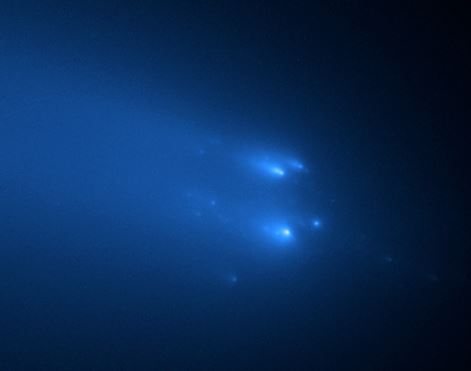
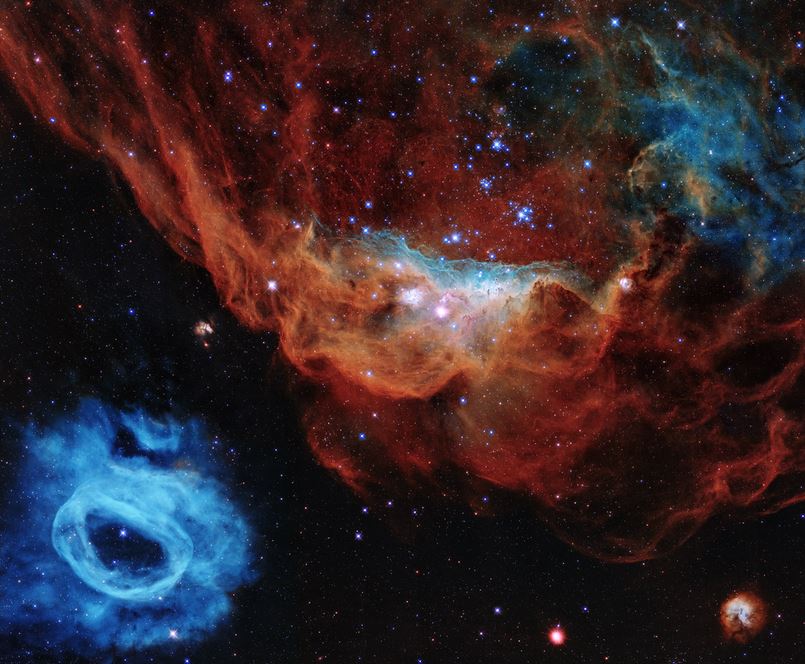
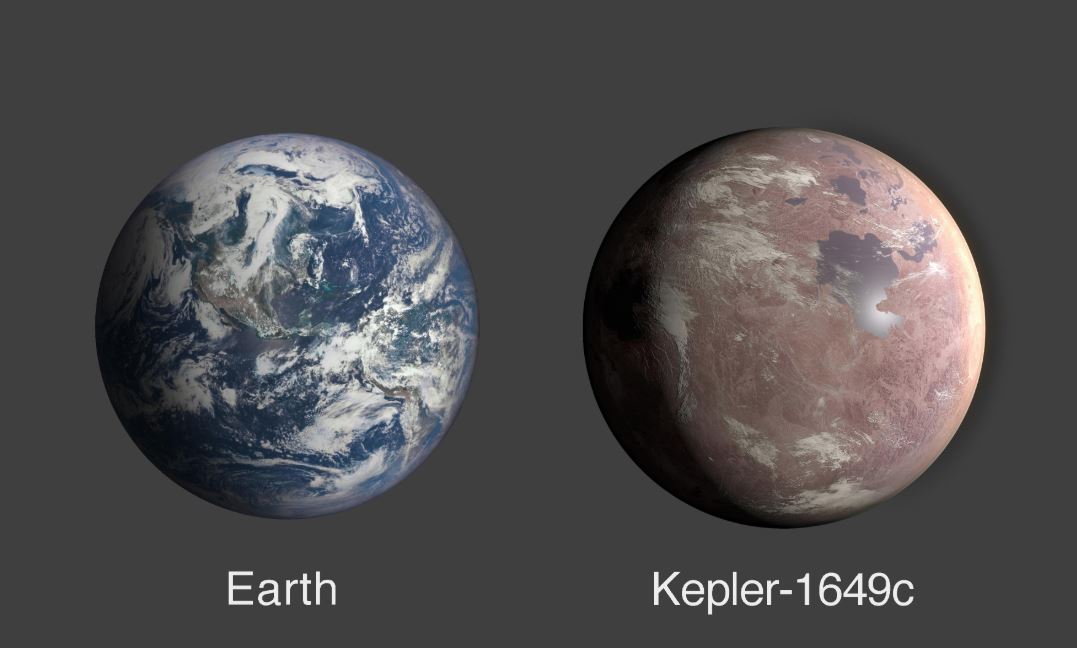
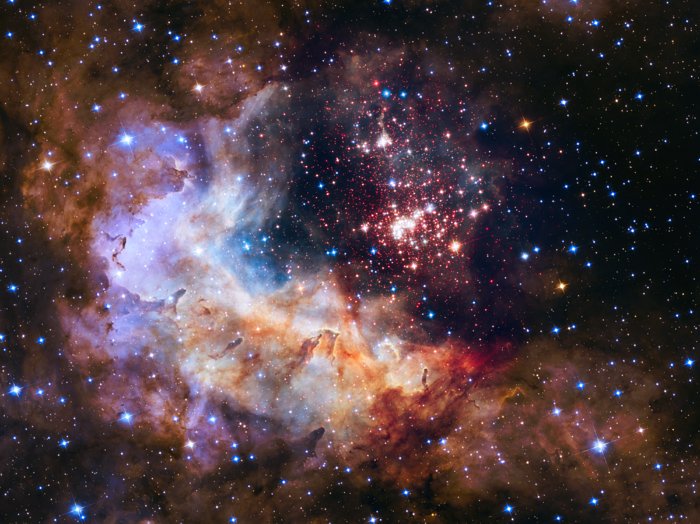

Recent Comments